The Mitsubishi Lancer Evolution, or “Evo,” has undeniably left a significant mark on automotive culture, particularly within the realm of rally racing. (en.wikipedia.org) However, Mitsubishi’s influence extends far beyond this iconic model. The brand has a rich history of producing innovative vehicles that have excelled in various domains, from off-road adventures to groundbreaking design and performance. This article explores ten Mitsubishi models that have showcased the company’s diverse engineering prowess and its impact on the automotive world.
Mitsubishi Motors has long been recognized for its innovative spirit and diverse lineup of vehicles that have left a lasting impression on automotive enthusiasts. From the rugged Pajero to the sporty Lancer Evolution, the brand has produced models that have garnered dedicated followings. However, several of these promising vehicles were discontinued prematurely, leaving fans to reminisce about what could have been. This article delves into ten Mitsubishi models that were cut short, exploring their unique qualities and the impact they had on the automotive world.
The 1990s were a transformative era in the automotive industry, marked by rapid technological advancements and the emergence of performance-oriented vehicles. Mitsubishi, a prominent Japanese automaker, introduced several innovative models during this decade that, despite their groundbreaking features, did not receive the recognition they deserved. This period saw the rise of vehicles that combined cutting-edge technology with impressive performance, setting new standards in their respective segments. In this article, we will explore ten Mitsubishi cars from the 1990s that, in hindsight, were ahead of their time and worthy of greater acclaim.
While in California this year for Monterey Car Week, I was able to attend The Quail, A Motorsports Gathering. Other than the Pebble Beach Concours, this was the only event I actually went to this year and, boy, am I happy I did.
While walking around the show area near a great Shelby Mustang display, I saw a small light green car peeking between the many GT350s. I walked over to and saw discovered the Morgan Motor Company display—and the car I had seen was the new 2025 U.S.-legal Plus Four.

I spent quite a bit of time looking at the car with my friend David Lillywhite, who is also the editor and founder of Magneto and Octane magazines. We discussed just how good the fit and finish on the car was. We ogled the car some more, and then David introduced me to James Gilbert, the head of PR and Communications for Morgan. After a quick conversation, I asked James if I could sit in the new Morgan and he said, “Of course—that’s why the car is here!”
I have loved Morgan cars for decades—especially the roadsters—but have always had one insurmountable issue with the cars: I have never been able to fit in a Morgan two-seater. Nevertheless, I decided to give it a try with this new Plus Four and found that not only did I fit, I also was actually quite comfortable behind the wheel. I came away stunned and worked out a way for me to drive one for this review.

To do a little backtracking, the reason I love Morgan vehicles and the Morgan Motor Company is that it is truly the last of the old British car companies. The factory is in the same location of Malvern Link in Worchestershire, England, as it has always been. In fact, the Plus Four is produced in the same factory in which they have always built the Morgan four-wheeled car. In addition, the company does not have—nor has Morgan ever had—an assembly line; the cars are built by hand in an assembly hall. These cars are produced by expert craftspeople, one at a time. The fact the company is still in business in 2025 and no other car company in the world resembles anything like this early 19th-century throwback is what makes Morgan a fascinating automaker. Morgan cars have soul and are the very definition of the classic British sports car.
Take a look at these photos of the Morgan factory in 1966 taken by Maurice Bruton:


Now here are a few factory photos from 2025:
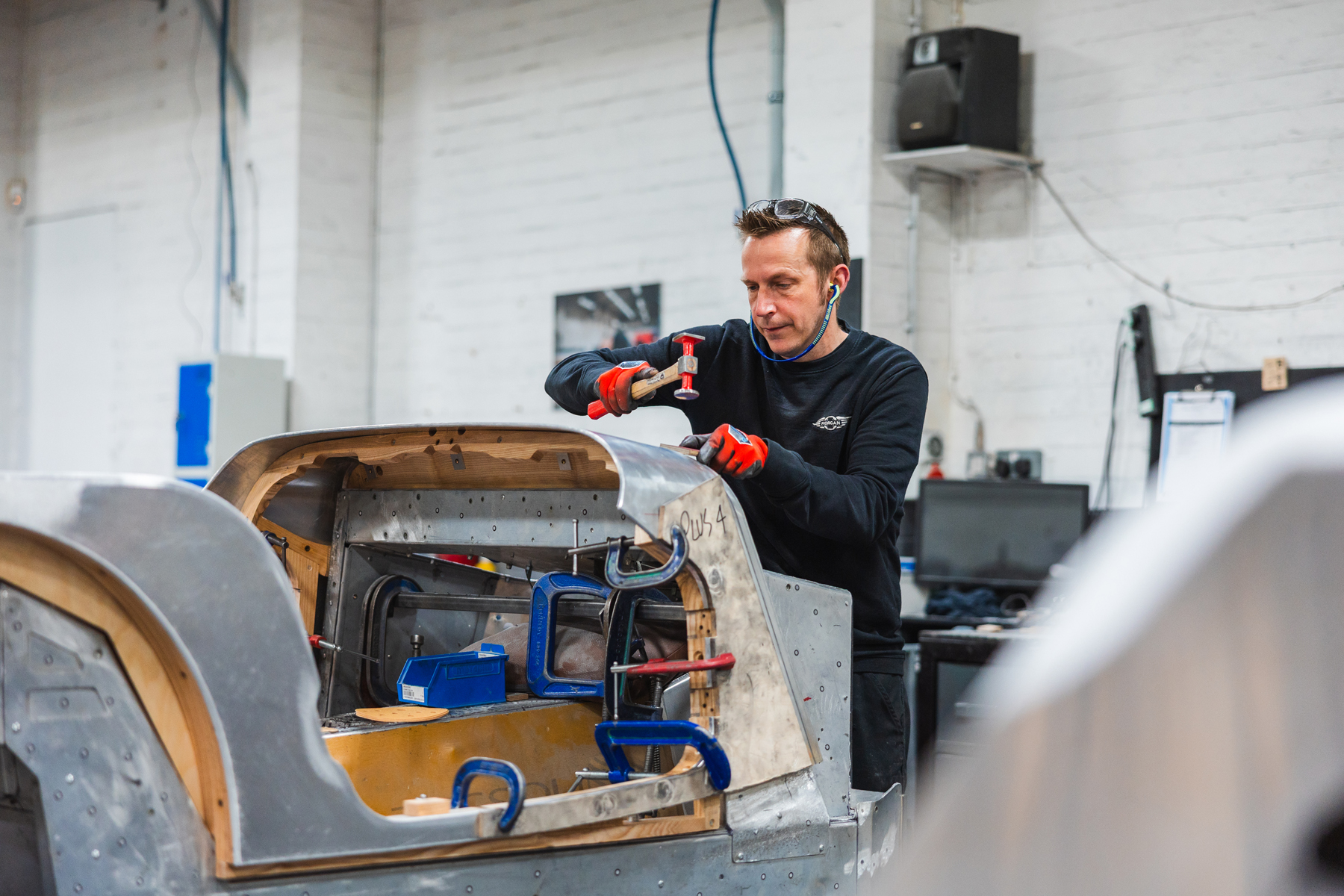
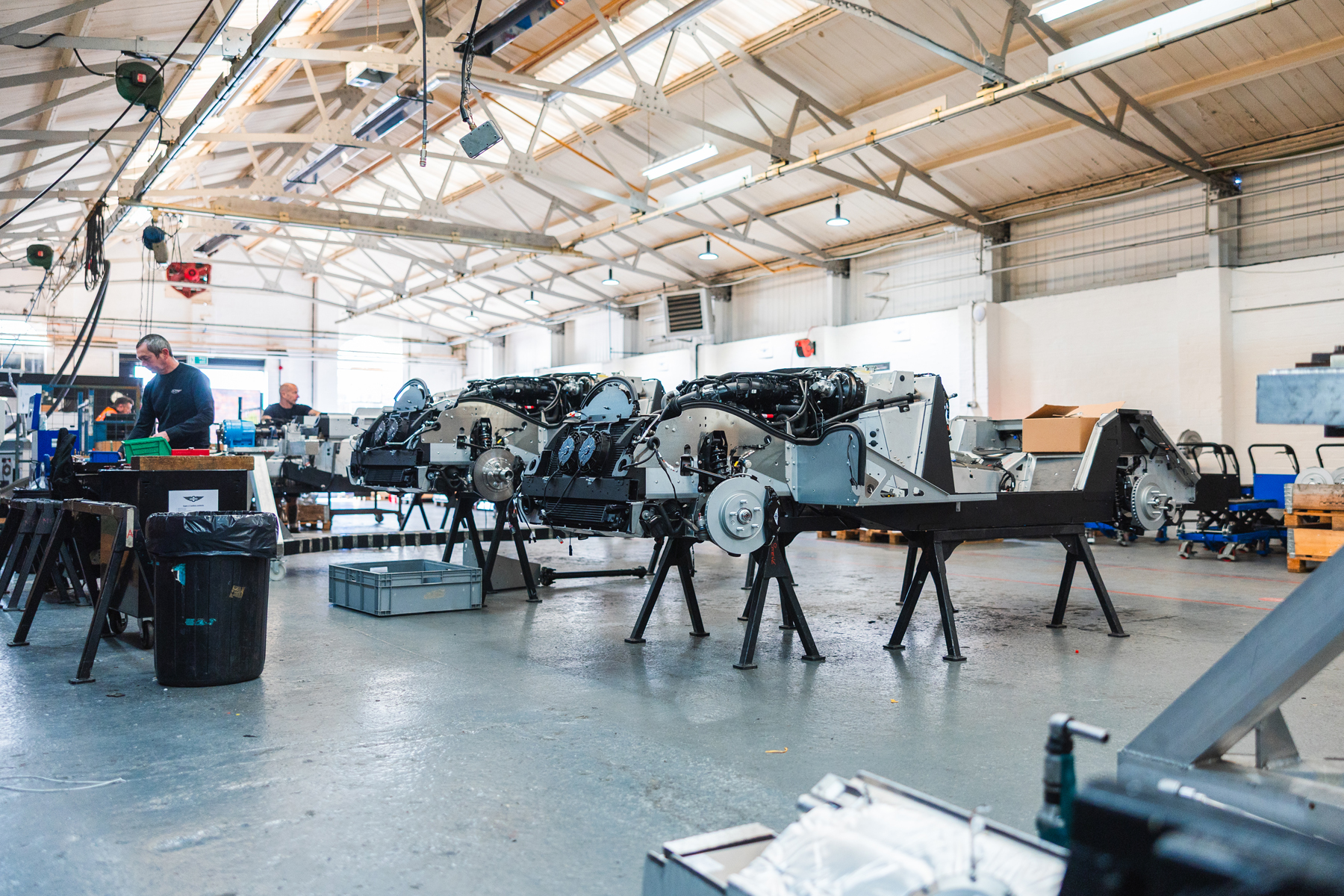
Sure, the factory is tidier and better organized, but the build process is somehow the same today and happening in the same location. Yes, the car is still handmade in aluminum. Yes, that aluminum body is over a wood framework. No, the chassis is not wood and never was. In the old days it was steel, and now it is made of aluminum. The fact that Morgan is still here is nothing short of amazing. There is literally no other automaker in the world that resembles Morgan Motor Company.

A few weeks after Monterey Car Week, while attending the Lime Rock Historic Festival, I was loaned a 2025 Plus Four by Larry Eckler, the owner of Morgan Motors of New England and Morgan Spares and the dealer closest to me in Connecticut. I took some time shooting photos of the car’s details, like the exquisite door handles and the BMW engine under the hood. I discovered a really cool angle was from the back, shooting into the passenger compartment. Everywhere I looked, the fit and finish were nothing short of perfection.

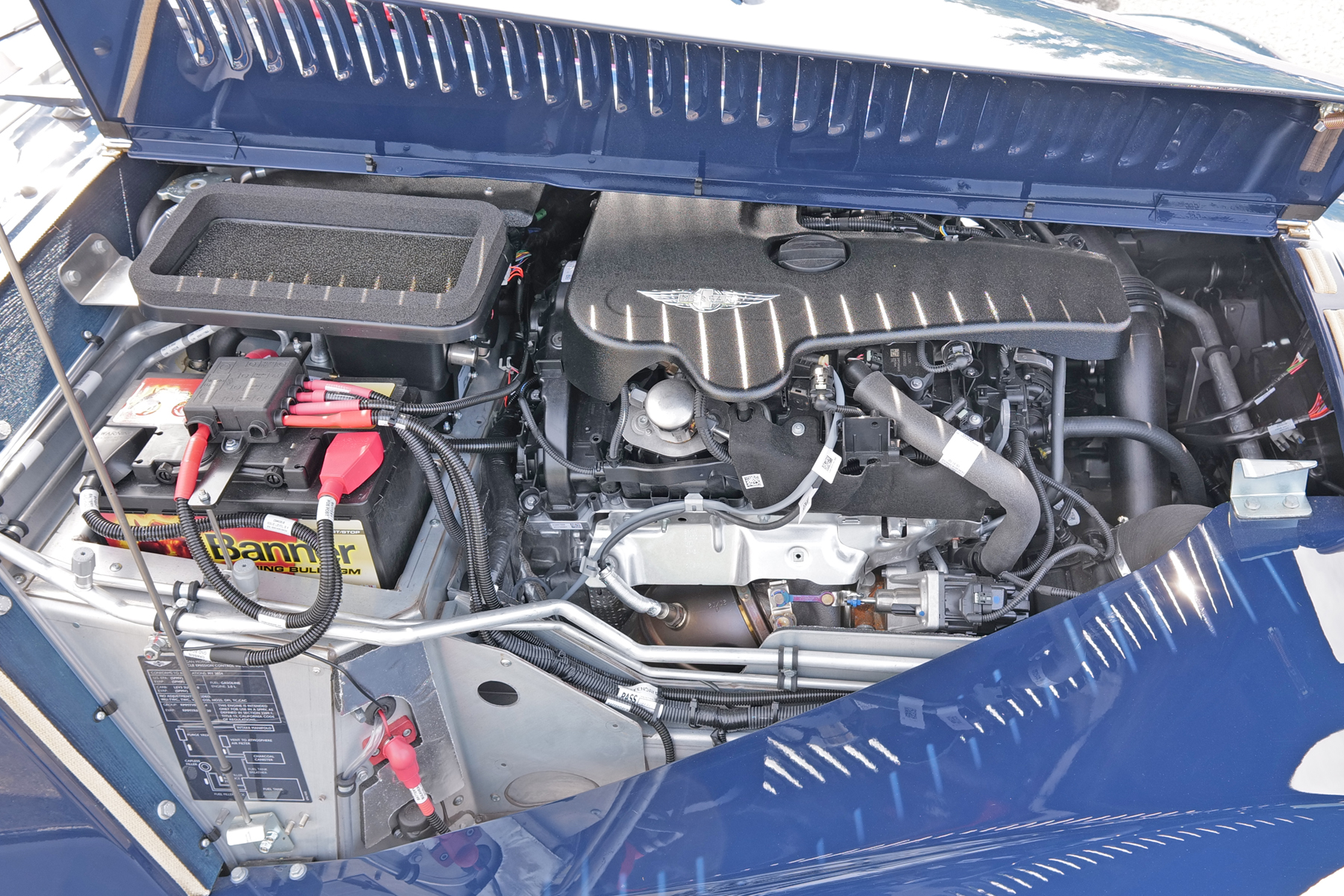

Larry and I headed out of the gate together, with me behind the wheel, and took a drive on the country roads around Lime Rock Park. These roads were made for cars like the Morgan, and we quickly motored through the countryside. After around 15 miles, we headed back to the dealer display area, where I began to make notes from my time driving the car.

The 2025 Morgan Plus Four is, in a word, exceptional. The chassis is amazingly communicative as well as quite stiff; the manual steering has a better feel than any other car built today. The way the car handles sharp bends is incredibly confidence-inspiring, and the car takes corners almost like a race car. It is as if the Plus 4 whispers in your ear to “take this next bend a little faster” and, when you do, it delivers—holding the road with amazing adhesion limits and no drama. When pushed a bit harder, the car responds as you would want it to, with a little bit of slide from the rear that is easily catchable with a slight turn of the steering wheel. Oh, and I can’t forget to mention the lack of any rattles or scuttle shake from the front of the car. Somehow this small classic sports car feels as solid as a BMW M3.

Yes, the transmission of the 2025 U.S.-spec model is equipped with only one gearbox, the ZF 8-speed used in BMW models. Before you complain about this, drive one of these cars. The transmission not only shifts much faster than I can, but also in sport mode it makes shifts at the same time and at the same rev range that I would have done myself with a manual. (Plus, notice the wood detailing on the tunnel.)


The most impressive thing about the new Plus Four is just how refined it is. That might sound like a crazy word to use to describe something basically based on a classic British sports car of the 1930s that doesn’t even have proper door window glass, but the Plus Four is one of the finest-built roadsters I have ever driven. The way the doors close, the fit and finish of everything—from the body panels to the interior bits —seems more on the level of Aston Martin or Rolls-Royce then the Morgans of old. Yes, old Morgans were properly built, but the new Plus Four is what you get when you spend a lot of money taking a classic design and building it as well as possible, using the very best traditional materials combined with some newer materials that don’t take away the car’s “Morgan-ness” but just make it as good a Morgan as possible.

I came away after my time with the 2025 U.S.-spec Morgan Plus Four desperately wanting one. The car makes no sense in today’s world (again, it doesn’t even have door windows), but it is the very essence of a traditional sports car—the ones that made the entire idea of a sports car something to be desired in America. It adds all the things a car needs today to be able to be usable not only as a weekend plaything, but also as a car that you could honestly use day to day (weather permitting). It is the perfect classic car to take on a cross-country trip, to a show, to park in a British car corral on a vintage racing weekend, or even to dinner with someone special on a Friday night. In fact, I would guess that dropping the new Plus Four at valet parking at a high-end hotel or restaurant would cause more interest and commotion than someone arriving in a $350,000 Ferrari.

Also, do not forget that a Morgan is a truly bespoke car. You can choose any color you want, your leather (including the piping, stitching, and color), and wheels and trim. The people at Morgan have given us the opportunity to build the classic sports car of our dreams for less than the cost to restore one. If you would like more information on how to get one of these amazing cars, visit Morgan’s website. The car configurator is especially fun to play with (so far, I have built five, with the most expensive one being $110,550). As they say on their site, “Adventure Awaits.”
We featured footage a bit over a month ago from the Pure Stock Muscle Car Drag Race. Pictures are fine, but we know there’s a segment of the population who wants to read about ETs. With over 100 cars duking it out, it’s difficult to remember everything (if not anything), especially while announcing from the tower.

Now, you can view all the cars – which ones were winners, their qualifying runs, their fastest ETs, and more. We trust you will find this information valuable in your bench-racing discussions.
Wanna race? Learn what it takes to attend the 2026 Pure Stock Muscle Car Drag Race by clicking here.



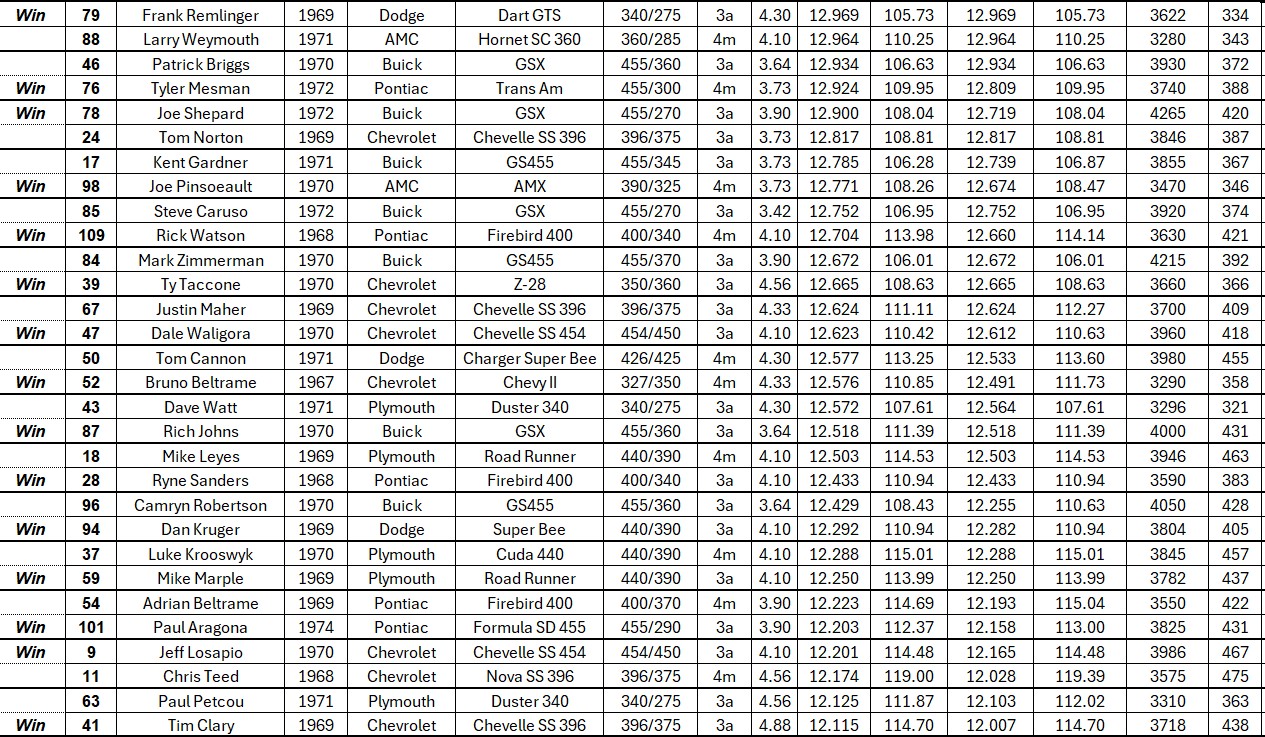

It is impossible to overstate the importance of the 2002’s contribution to the success of the BMW brand. If it wasn’t for the 2002, BMW may not have continued to be a car company. When the 2002 was out, BMW coined the tagline “The Ultimate Driving Machine.” In the late-1960s and 1970s, the 2002 put BMW on the map with that first important group of influencers: automotive journalists and enthusiast owners. The leader of that original influencer group, David E. Davis, who at the time was editor of Car and Driver magazine, wrote the best description of the 2002 BMW could have ever asked for. In his 1968 road test of the car, he said, “To my way of thinking, the 2002 is one of modern civilization’s all-time best ways to get somewhere sitting down.”

Davis went on to say, “The BMW 2002 may be the first car in history to successfully bridge the gap between the diametrically-opposed automotive requirements of the wildly romantic car nut, on one hand, and the hyperpragmatic people at Consumer Reports, on the other.”
Reviews like this made the BMW 2002 an overnight success with enthusiasts. BMW elevated the car to its ultimate specification with the introduction of the 2002 tii model, which added fuel injection to the mix, giving the 2002 a sizable increase in power. All this made a great car even better. People lined up to buy the 2002, adding themselves to waiting lists at dealers – something that was not very common at the time and probably a first for BMW.

I have personally owned a 2002 and driven a number of the models, and I will state right now that the 2002 tii is worth all the hype. It is a true enthusiast car from the era with great handling, more power than most of its 1960s and early-1970s competition, and fun to drive. The 2002 is able to wipe the floor with MGBs, Healeys, Alfas, Triumphs, and even many Porsche cars of the era, without breaking a sweat. It is – in a word – capable. All these characteristics make it a historical icon for the BMW brand.
Today’s AutoHunter Spotlight is one of these amazing cars, a 1974 BMW 2002 tii located in Gladstone, Oregon.
The selling dealer describes this 2002 tii as being powered by its correct fuel-injected 1,990cc inline-four mated to a four-speed manual transmission. The car is finished in Polaris Silver over a blue leather interior and offered by the dealer with a clear title.

Polaris Silver is the original color for this car, as shown by the factory color sticker. The car is nicely equipped with a manual sunroof and factory alloy wheels. I can see no evidence of any damage or issues with the body in the photos, but I recommend having any car you want to buy online inspected, no matter where it is coming from.

The interior seems to be in great shape, with factory-correct seats covered in blue leather. The only two changes from stock are the aftermarket steering wheel and the Ungo Box alarm keypad mounted on the center console. I doubt that the alarm still works, but it is a cool piece from the era when the car was new. I also love that the dash does not appear to be cracked and that all the gauges and such are correct for the car.

Under the hood is the 1,990cc SOHC fuel-injected inline-four engine, which is backed by a four-speed manual gearbox. It looks to me as if the owner got a little crazy polishing things, but that really just shows enthusiasm for the car. If you don’t like it, just wait a few months and most of the shine will fade away.

Here is a bit of an insider’s fact: This is a second-series 2002 tii, meaning it has bigger bumpers and square taillights. Many people prefer the earlier round-taillight, small-bumper cars, but the fact is that those feel exactly the same from behind the wheel. In addition, those larger bumpers actually protect the car from people who park by touch much more than the small bumpers do on the early cars. All this means that these later 2002 tii models often cost less than the early ones despite being, in essence, the same. Does that sound like a potential bargain? I have always thought so.
If this 1974 BMW 2002 tii is of interest to you, bid on it. Do that soon because the auction for this icon ends on Wednesday, October 29, 2025, at 12:45 p.m. (PDT).
Visit the AutoHunter listing for more information and a photo gallery
Imagine completely restyling the exterior of your house. Now think about doing the same thing just one year later. That’s essentially what Hudson did for the 1937 model year, which “meant the complete redesigning of cars that were completely new for 1936” and an increase in power. Our Pick of the Day benefits from those improvements as well as a restoration finished by specialist James Mundstock. This 1937 Hudson Terraplane Cab Pick-up is listed on ClassicCars.com by a dealership in Scottsdale, Arizona.
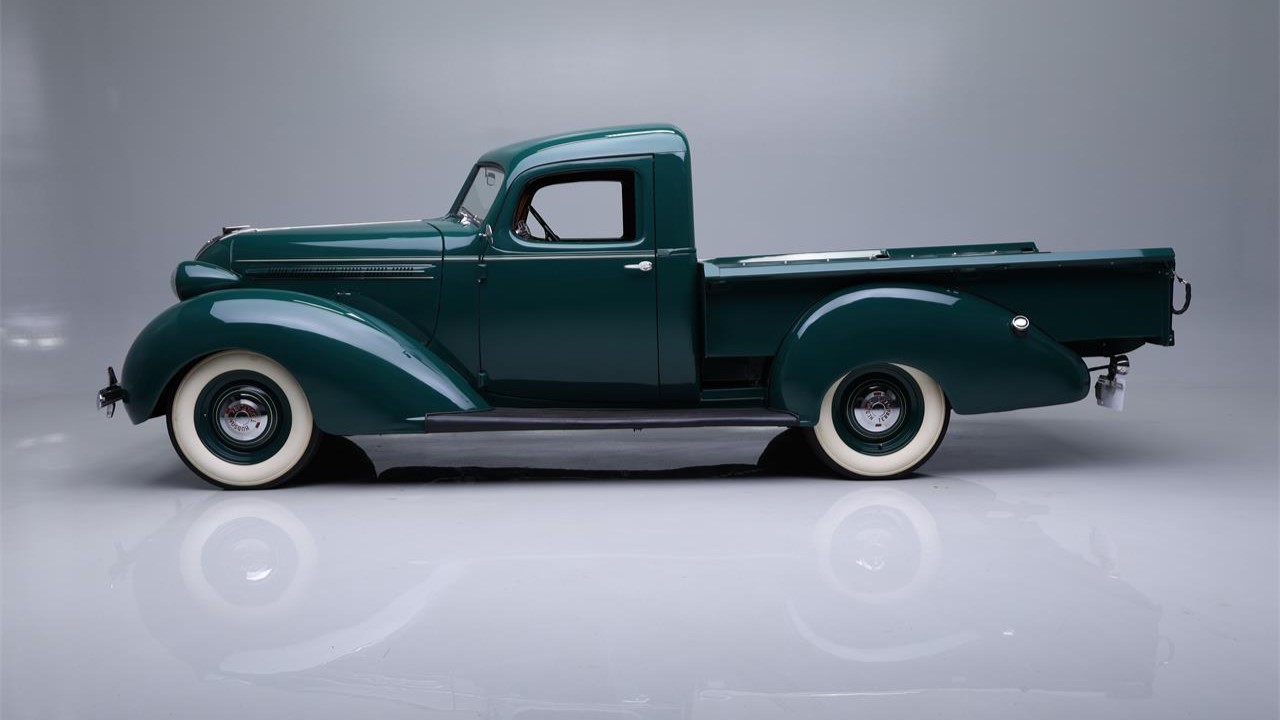
According to a guidebook about its 1937 models, Hudson said the overhaul “called for completely new body dies, fender dies, hood dies and for important changes throughout the chassis.” Double carburetion helped increase engine output, which jumped to heights of 96 or 101 horsepower for Terraplane models and 101 or 122 for Hudson models. This Terraplane Cab Pick-up was part of Hudson’s line of Terraplane Commercial Cars, which had all-steel bodies mounted on the new boxed Double Drop “2-X” Frame. Approximately 11 years ago, someone started bringing this truck back to its former glory. As restoration specialist James Mundstock says in this video, he assisted in the process, but after the primary restorer died, Mundstock ended up finishing it.
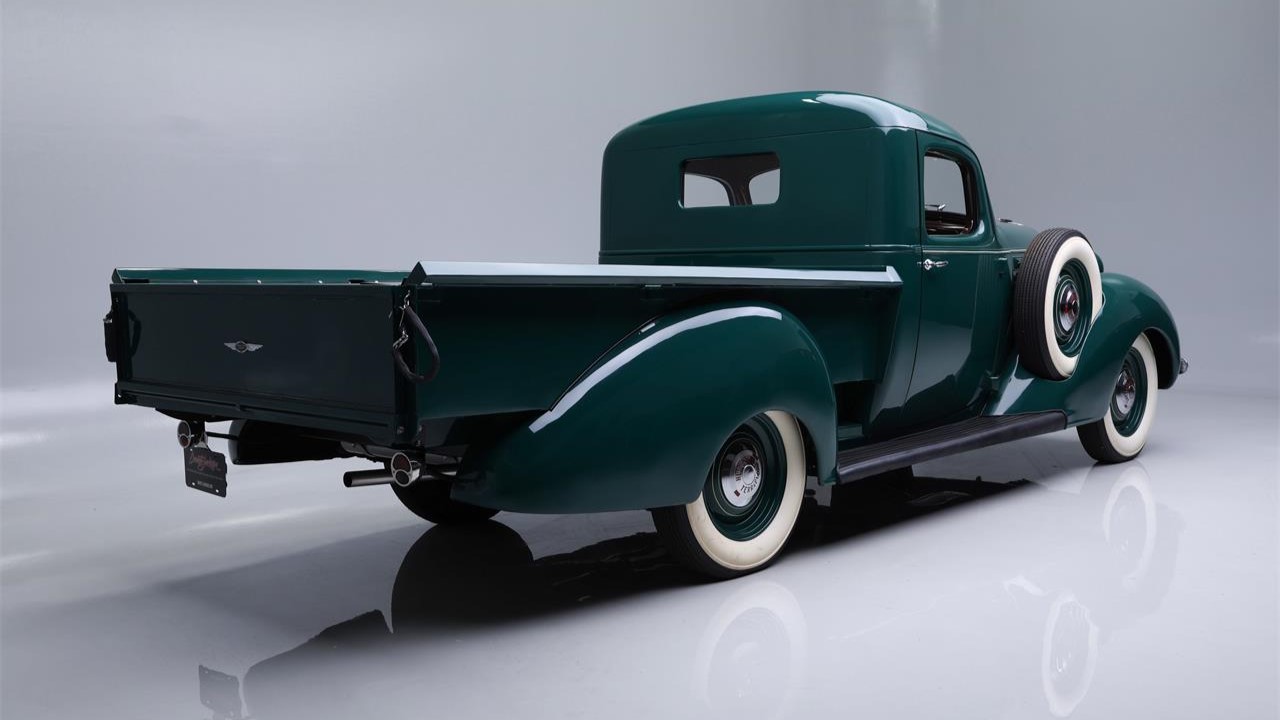
What a job well done. Not only is this truck a great design with sweeping curves, but its dark green exterior – with wide-whitewall tires – and tan interior colors make it even more attractive. The bed, which extends past the rear bodywork, helps make the most of this truck’s three-quarter-ton rating. Its tailgate flips down to reveal storage areas for things such as tools and the original screw jack.
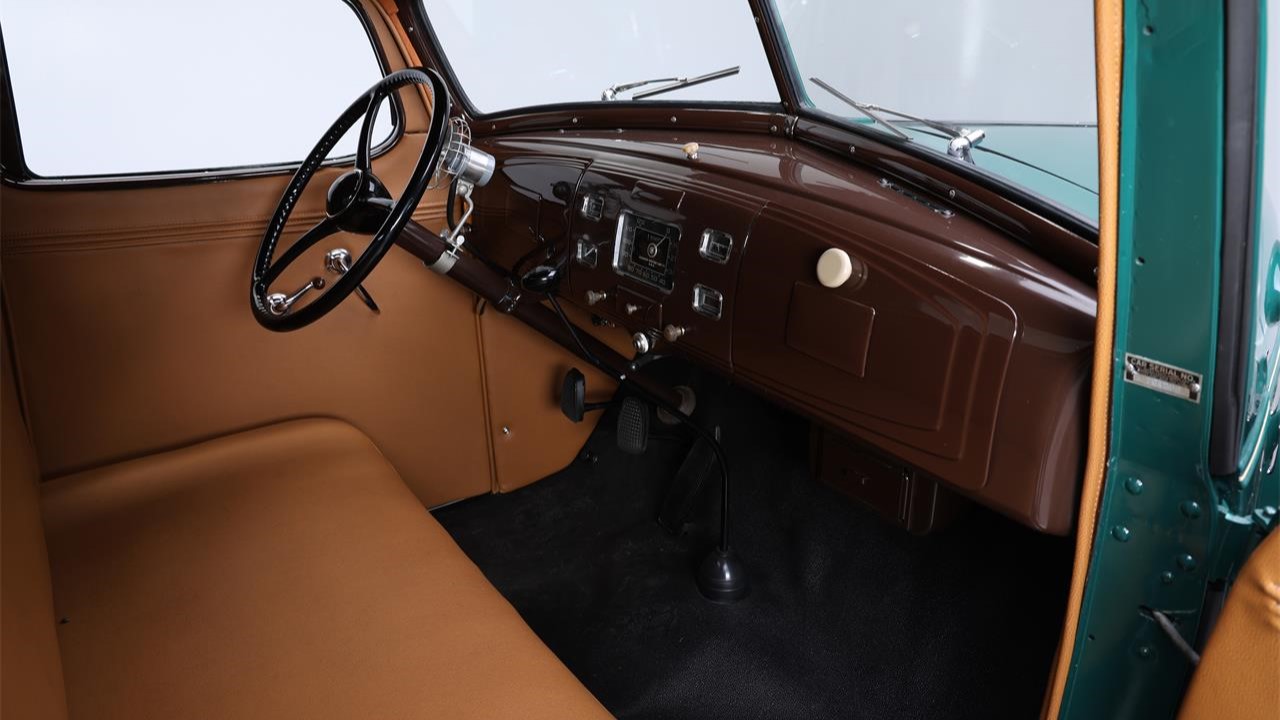
The cab’s interior features thoughtful comfort and convenience features. A knob on top of the brown dashboard controls the vacuum-operated windshield wipers. Climate control hardware consists of a steering column-mounted fan and a dealer-installed heater with doors that can be opened to direct warm air toward the driver or flipped up to make things more pleasant for the passenger.
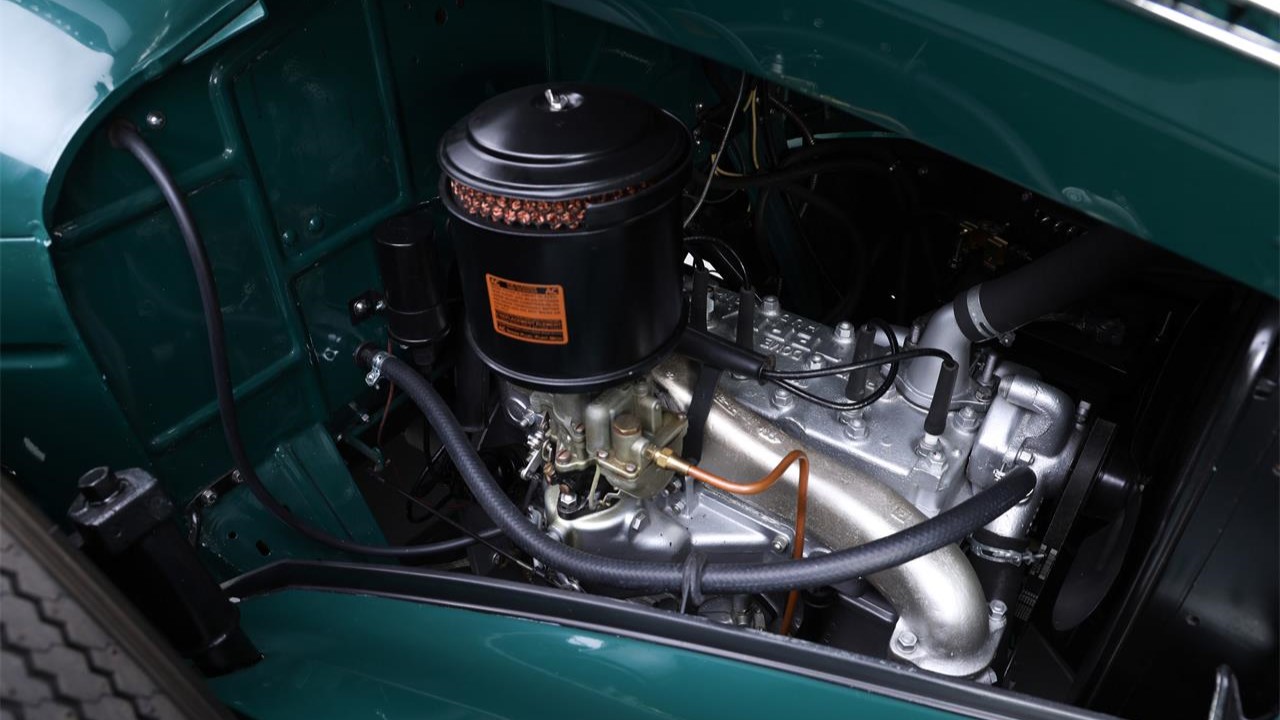
As part of the overhaul, an electric fuel pump was added to make starting up the original 212ci inline-six easier. The base level of output was 96 horsepower, but do you see the “Power Dome” lettering on the cylinder head? That means this I6 was equipped with a higher 7:1 compression ratio and 102 horses, which are directed by a three-speed manual gearbox.
Many classic vehicles need a long list of updates. This 1937 Hudson Terraplane Cab Pick-up isn’t one of them. In many ways, it was new for ’37; now it’s new once again for you. You can make it yours for $72,900.
Click here to view this Pick of the Day on ClassicCars.com
This custom street rod was built in 2020 using bodywork from a 1955 Ford Ranch Wagon mounted to the underpinnings of a 2013 Chevrolet Caprice Police Patrol Vehicle. The car features forward-tilting hood along with wheel arch flares and is finished in metallic brown and gloss black. It is powered by a 6.0-liter V8 linked to a 6L80E six-speed automatic transmission and rides on an independent suspension coupled with 18” steel wheels and disc brakes at all four corners. Inside, front bucket seats trimmed in distressed brown leather are accompanied by a black cloth–trimmed rear bench as well as a Bluetooth-capable sound system, automatic climate control, cruise control, and power front windows. Acquired by the seller after its completion, this custom Ranch Wagon street rod is now offered with a Carfax report for the donor Caprice and a clean California title in the seller’s name listing it as a 1955 Ford.

The Caprice PPV’s body panels were removed, and the upper portions of the unibody were cut away before the Ranch Wagon body was grafted onto the chassis. The hood was modified to tilt forward and wheel arch flares were added before the car was painted in metallic brown with gloss-black pillars and bumpers. The car has tinted glass and sliding side windows, and it is not equipped with windshield wipers.

The 18” steel wheels wear chrome trim rings and are wrapped in 235/50 Falken Ziex ZE950 A/S tires. Adjustable rear coilovers have been installed, and braking is handled by four-wheel discs with ABS.

The cabin features front bucket seats trimmed in distressed brown leather that extends to the dash, center console, and shifter. A folding rear bench seat is covered in black cloth, and amenities include a Bluetooth-capable sound system as well as automatic climate control, cruise control, and power front windows.

The multifunction steering wheel fronts a 160-mph speedometer, an 8k-rpm tachometer, and gauges for coolant temperature and fuel level along with a central information display. The digital odometer indicates 65k chassis miles, approximately 1k of which were added under current ownership. The air bags do not work, and the warning light is illuminated.

Aftermarket speakers are installed in the side panels, and two subwoofers are mounted in the cargo area floor.

The 6.0-liter L77 V8 was rated at 355 horsepower and 384 lb-ft of torque when new. Speed Engineering headers flow into a stainless-steel dual exhaust system with Street Series Street Max mufflers. The car is not equipped with catalytic converters, and the Check Engine light is illuminated.

Power is sent to the rear wheels through a 6L80E six-speed automatic transmission.

A Carfax report for the 2013 Chevrolet VIN 6G1MK5U23DL829522 is presented in the gallery and lists an accident in January 2015 as well as a junk title issuance in May 2020.

The 1955 Ford serial number U5LR131266 and 2013 Chevrolet VIN 6G1MK5U23DL829522 are shown above. The car is titled as a 1955 Ford station wagon using the former sequence, and the document carries a “Title Only” notation. The vehicle has not been inspected by the California Bureau of Automotive Repair.
Throughout its history, Volkswagen has consistently surprised the automotive world with vehicles that perform beyond expectations. From dominating rally racing circuits to offering exceptional value in everyday driving, Volkswagen’s lineup includes several models that have defied the odds. This article explores ten remarkable examples of Volkswagens that have punched well above their weight class, showcasing the brand’s ability to deliver performance, innovation, and value in unexpected packages.
Volkswagen has a storied history of producing special edition models that cater to diverse tastes and commemorate significant milestones. These unique variants often remain under the radar, even for dedicated automotive enthusiasts. Exploring these rare editions offers a glimpse into Volkswagen’s innovative spirit and commitment to delivering distinctive driving experiences.
